In the dynamic world of digital marketing, email remains a vital tool for customer engagement and brand communication. As businesses strive to optimize their outreach strategies, choosing the right email marketing platform becomes crucial. Two prominent players in this field, Mailchimp and Campaign Monitor, offer unique features and capabilities to meet diverse marketing needs. This comprehensive comparison delves into the specifics of Mailchimp and Campaign Monitor, exploring their strengths, weaknesses, and suitability for different business types. Additionally, we’ll explore innovative solutions like Prism Reach that are shaping the future of email marketing.
Key Facts
- Mailchimp, founded in 2001, offers a more extensive feature set with advanced automation and e-commerce integration, while Campaign Monitor excels in deliverability and ease of use.
- Mailchimp provides a free plan for up to 2,000 subscribers, whereas Campaign Monitor’s pricing starts at $12/month with no free tier.
- Both platforms offer drag-and-drop editors, but Mailchimp boasts over 200 templates compared to Campaign Monitor’s more limited selection.
Navigating the Email Marketing Landscape: Mailchimp vs Campaign Monitor
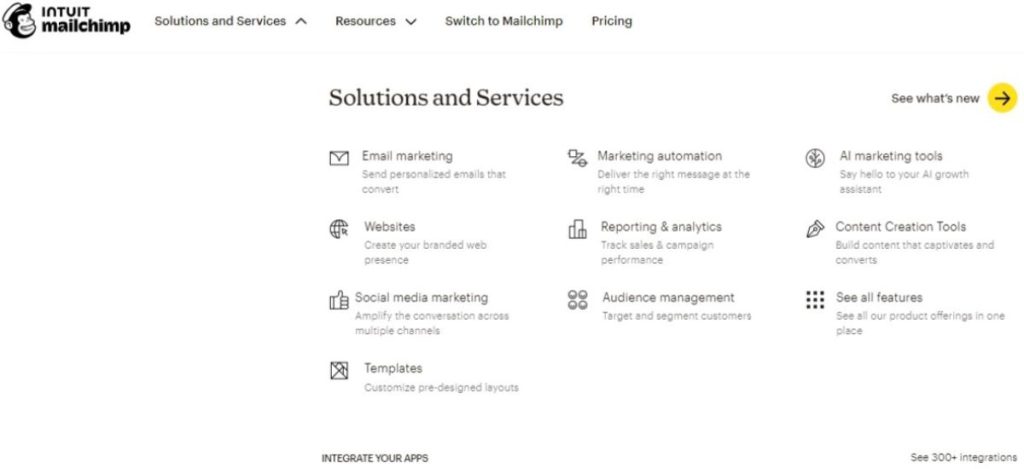
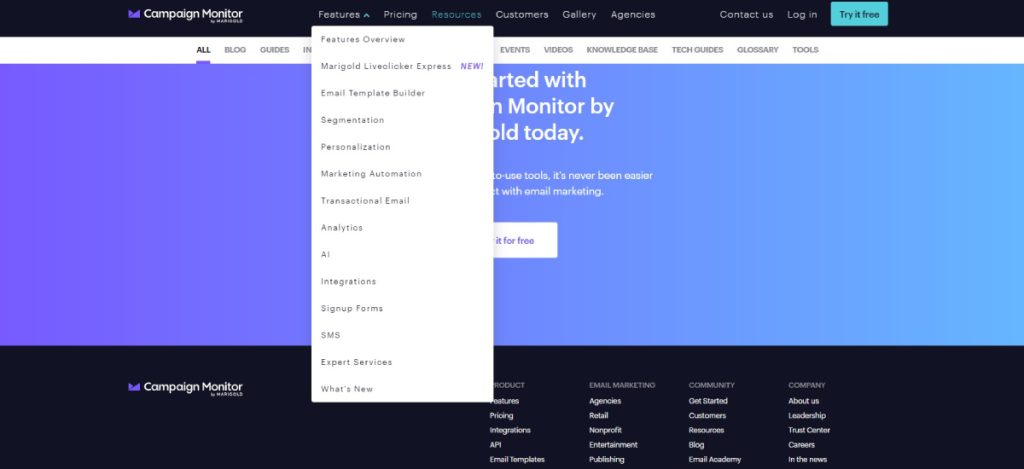
Comprehensive vs. Streamlined Approaches
Mailchimp has positioned itself as a comprehensive marketing solution, offering a robust feature set that extends beyond simple email campaigns. Its platform is designed to be an all-in-one marketing hub, with advanced automation capabilities, extensive e-commerce integrations, and cross-channel marketing features. This makes Mailchimp particularly appealing to businesses looking for a versatile tool that can handle complex marketing strategies across various channels.
On the other hand, Campaign Monitor has taken a more focused approach, concentrating on core email marketing functionalities. By prioritizing simplicity and ease of use, Campaign Monitor caters to businesses that prefer a streamlined, no-frills approach to their email marketing efforts. This focus on straightforward email campaigns makes it an excellent choice for those who want to create effective emails without navigating through a multitude of additional features.
User Interface and Ease of Use
The user interface is a critical factor in the adoption and effective use of any software tool. Mailchimp offers a user-friendly dashboard that features a visual drag-and-drop builder. This intuitive design makes it accessible even for beginners, allowing users to create sophisticated campaigns without extensive technical knowledge. Despite its feature-rich environment, Mailchimp manages to maintain an intuitive feel, striking a balance between functionality and usability.
Campaign Monitor takes the concept of simplicity a step further. Its streamlined interface is designed with ease of use as the top priority. This approach makes Campaign Monitor particularly appealing to users who want to create professional-looking emails quickly and efficiently. The platform’s focus on simplicity means that even those new to email marketing can navigate the tool with confidence, creating polished campaigns without a steep learning curve.
Automation and Workflow Capabilities
In today’s fast-paced marketing environment, automation is key to efficiency and scalability. Mailchimp shines in this area with its advanced automation features. The platform offers complex workflow options, including multiple paths and conditional logic. This level of sophistication makes Mailchimp an ideal choice for businesses with intricate marketing strategies, particularly those in the ecommerce sector. The ability to create detailed, responsive customer journeys based on various triggers and conditions allows for highly personalized and effective campaigns.
- Hidden Gem: Leverage Mailchimp’s Visual Segmentation Builder to create complex, multi-layered segments without coding. This tool allows for intuitive drag-and-drop creation of sophisticated audience targeting, potentially increasing open rates and engagement.
- Hidden Gem: Implement Mailchimp’s Multivariate Testing to simultaneously test multiple email elements. This allows for more comprehensive optimization compared to simple A/B testing.
- Hidden Gem: Use Mailchimp’s Send Time Optimization to automatically determine the best time to send emails to individual subscribers based on their past behavior.
Campaign Monitor, while offering email marketing automation, provides a more straightforward approach. Its automation features are designed for more basic tasks, making it suitable for businesses that don’t require complex workflow setups. This simplicity can be an advantage for small to medium-sized businesses or those just starting with email automation, as it allows them to implement effective automated campaigns without getting overwhelmed by excessive options.
- Hidden Gem: Exploit Campaign Monitor’s Click Heatmaps to visually analyze where subscribers are clicking in your emails. This insight can inform better email design and content placement.
- Hidden Gem: Utilize Campaign Monitor’s Conditional Logic to display different content based on specific subscriber criteria. This personalization can lead to higher engagement rates.
Segmentation and Personalization Strategies
Effective email marketing relies heavily on the ability to send targeted, relevant messages to specific audience segments. Mailchimp excels in this area, offering highly targeted segmentation options. Users can create multiple lists, tags, and groups, allowing for nuanced audience segmentation. One of Mailchimp’s standout features is its ability to segment based on purchase behavior, which is particularly valuable for ecommerce businesses looking to tailor their marketing efforts based on customer buying patterns.
Prism Reach enhances these capabilities by utilizing AI-powered user avatars, which enrich user data for creating highly personalized profiles. This ensures that each subscriber receives content that is not only relevant but also tailored to their specific interests and behaviors.
- Hidden Gem: Utilize Mailchimp’s Predictive Analytics to forecast future campaign performance. Use these insights to refine your email marketing strategy.
Campaign Monitor provides basic segmentation options, allowing users to segment based on subscriber details and custom fields. While these options are sufficient for many basic email marketing needs, they are less intuitive and comprehensive compared to Mailchimp’s offering. This difference in segmentation capabilities can be a crucial factor for businesses that rely heavily on highly targeted email campaigns to drive engagement and conversions.
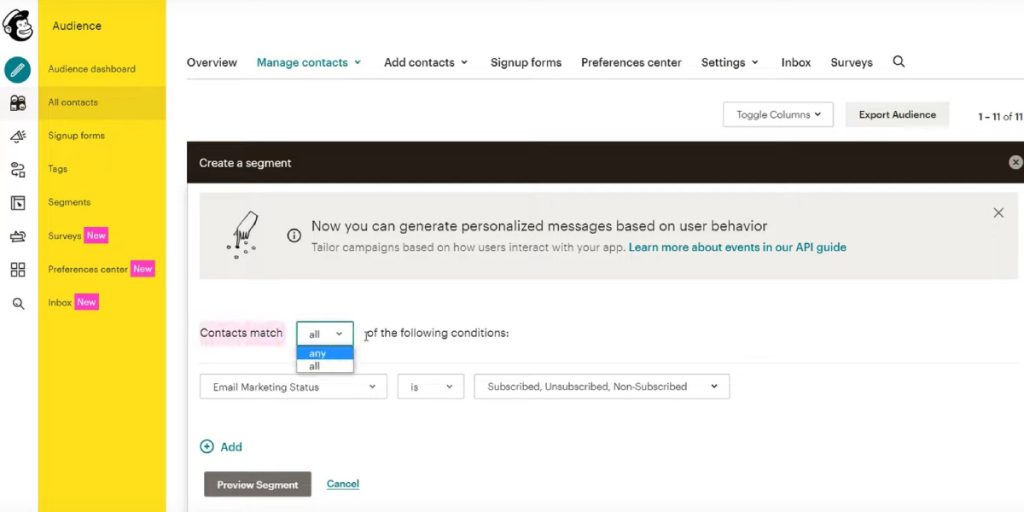
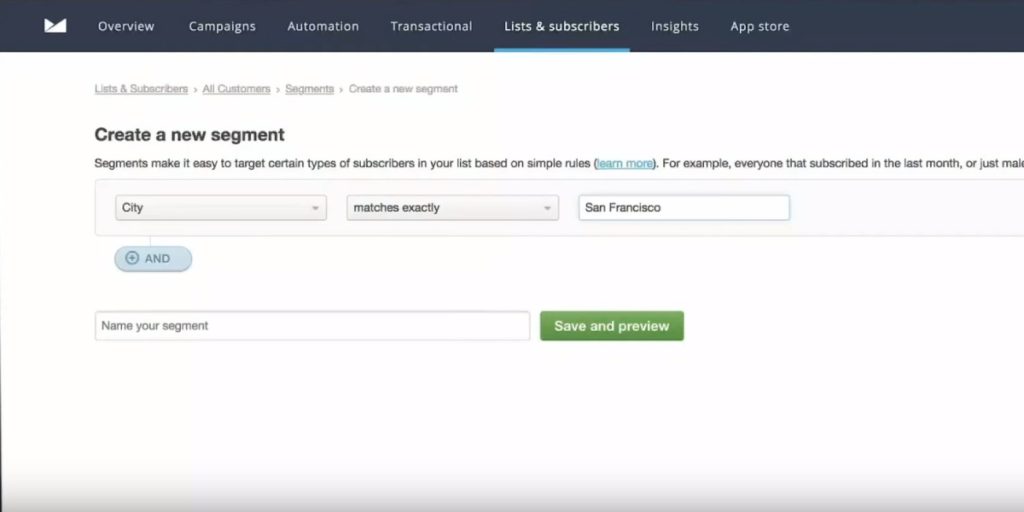
Analytics and Reporting Depth
In the data-driven world of digital marketing, robust analytics and reporting capabilities are essential for measuring campaign performance and making informed decisions. Mailchimp offers a comprehensive suite of analytical tools that provide deep insights into campaign performance. The platform includes features like heat maps, which offer visual representations of how subscribers interact with emails, helping marketers optimize their layouts and content placement. Mailchimp also provides comparative reporting, allowing users to analyze the performance of different campaigns side by side. Furthermore, its integration with Google Analytics enables marketers to gain a more holistic view of how email campaigns impact overall digital marketing efforts.
Prism Reach takes analytics a step further with its AI-driven insights, providing predictive analytics and sentiment analysis to better understand subscriber behavior and preferences. This allows marketers to make data-informed decisions that enhance campaign effectiveness.
Campaign Monitor, while providing essential analytics, offers a more streamlined approach to reporting. Users can access basic metrics such as opens, clicks, and other fundamental data points. This approach may be sufficient for businesses with straightforward reporting needs, providing quick and easy access to key performance indicators. However, for marketers requiring in-depth analysis and advanced insights, Campaign Monitor’s analytics capabilities may feel somewhat limited compared to Mailchimp’s more comprehensive offering.
Pricing Models and Value Proposition
The pricing structure of an email marketing platform can significantly impact a business’s decision, especially for small businesses or startups with limited budgets. Mailchimp offers a free plan for up to 2,000 subscribers, making it an attractive option for businesses just starting with email marketing or those with small subscriber lists. This free tier allows users to explore many of Mailchimp’s features without financial commitment. Paid plans start at $9.99 per month, with pricing increasing based on the number of subscribers and features required.
Campaign Monitor takes a different approach to pricing, with no free plan available. Their pricing structure starts at $12 per month for basic features, with costs scaling based on subscriber count and desired functionality. While this might seem less appealing for very small businesses or startups, Campaign Monitor’s pricing can be more cost-effective for larger subscriber bases, especially when considering the platform’s focus on deliverability and ease of use. The choice between the two platforms often comes down to balancing feature needs with budget constraints.
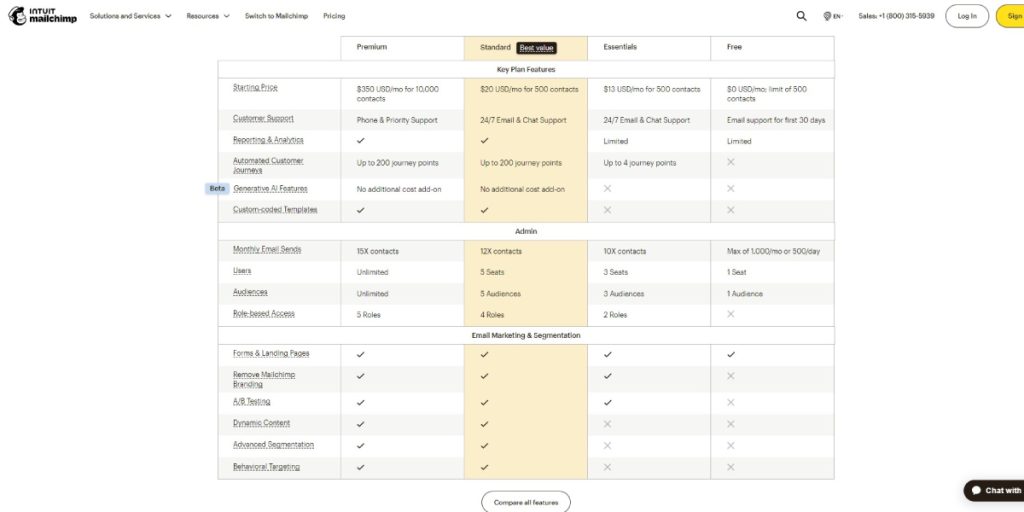
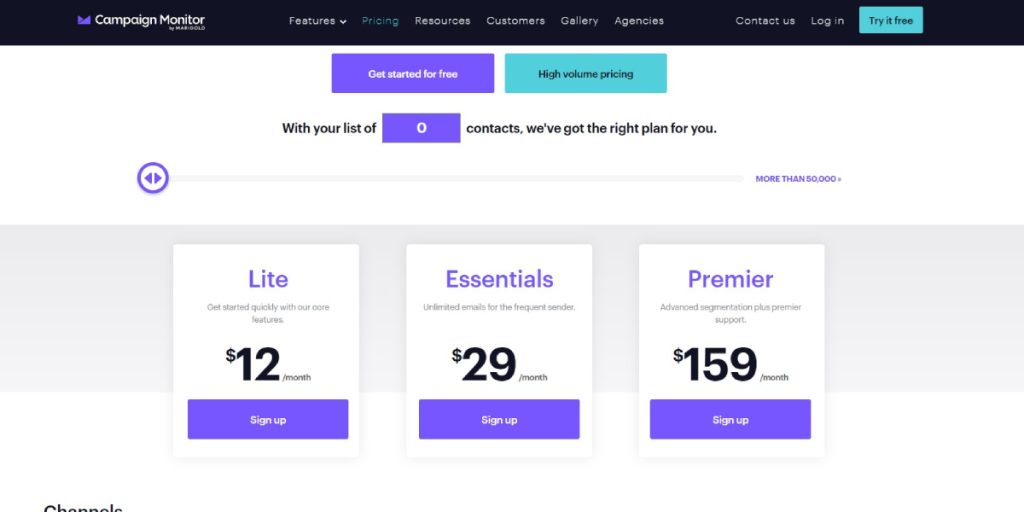
Deliverability Performance
Email deliverability is a critical factor in the success of any email marketing campaign. Both Mailchimp and Campaign Monitor prioritize this aspect, recognizing its crucial role in ensuring that marketing messages reach their intended recipients. Campaign Monitor has a particularly strong focus on deliverability, closely monitoring IP reputation and sender behavior to maintain high inbox placement rates. They employ proactive measures to ensure emails reach their intended recipients, which can be a significant advantage for businesses where every email counts.
Mailchimp also offers robust deliverability rates, employing proactive monitoring and encouraging domain authentication. While both platforms perform well in this aspect, Campaign Monitor’s reputation for excellent deliverability could be a deciding factor for businesses where email reach is a top priority. The choice between the two platforms in terms of deliverability may come down to specific industry needs and the importance of inbox placement for a particular business model.
Integration Ecosystem
In today’s interconnected digital landscape, the ability of an email marketing platform to integrate seamlessly with other tools and services is crucial. Mailchimp takes the lead in this area with its extensive network of integrations. The platform offers seamless connections with a wide range of popular tools and platforms, including Shopify, WordPress, Salesforce, and many others. This broad ecosystem of integrations makes Mailchimp particularly appealing for businesses using multiple tools and looking for a centralized marketing hub. Additionally, Mailchimp provides an API for further customization, allowing businesses with technical resources to create tailored integrations.
Campaign Monitor, while offering a range of integrations, provides fewer options compared to Mailchimp. However, it does integrate well with popular ecommerce platforms like Shopify, making it a viable option for online retailers. The more limited integration options of Campaign Monitor align with its focus on simplicity and core email marketing functions, which may be sufficient for businesses with less complex tech stacks. When choosing between the two platforms, businesses should consider their current and future integration needs to ensure their email marketing tool can grow with their technological ecosystem.
Customer Support and Resources
The level and quality of customer support can significantly impact the user experience, especially for those new to email marketing or encountering complex issues. Mailchimp offers 24/7 email support for paid plans, ensuring that help is always available when needed. Live chat support is available for higher-tier subscribers, providing more immediate assistance for urgent issues. Additionally, Mailchimp offers a wealth of learning resources, including a comprehensive knowledge base, making it easier for users to troubleshoot issues and learn new features independently.
Campaign Monitor provides a range of support options, including live chat, phone, and email support. However, the availability of these support channels may depend on the user’s pricing tier. While their resource library may not be as extensive as Mailchimp’s, they offer focused, practical guidance on email marketing best practices. The choice between the two in terms of support may come down to individual preferences for support channels and the depth of self-help resources desired. Businesses should consider their team’s technical expertise and the level of support they anticipate needing when making their decision.
Innovative Solutions by Prism Reach
While Mailchimp and Campaign Monitor offer robust solutions for email marketing, Prism Reach is introducing innovative AI-powered technologies to the field. Prism Reach is a SaaS solution designed to provide highly personalized newsletters for publishers, blogs, forums, and eCommerce businesses.
Prism Reach leverages advanced AI technology to create a unique email marketing experience tailored to individual subscriber interests. Unlike traditional platforms that focus on segmentation, Prism Reach treats each subscriber as an individual, creating multiple personalized emails for each recipient.
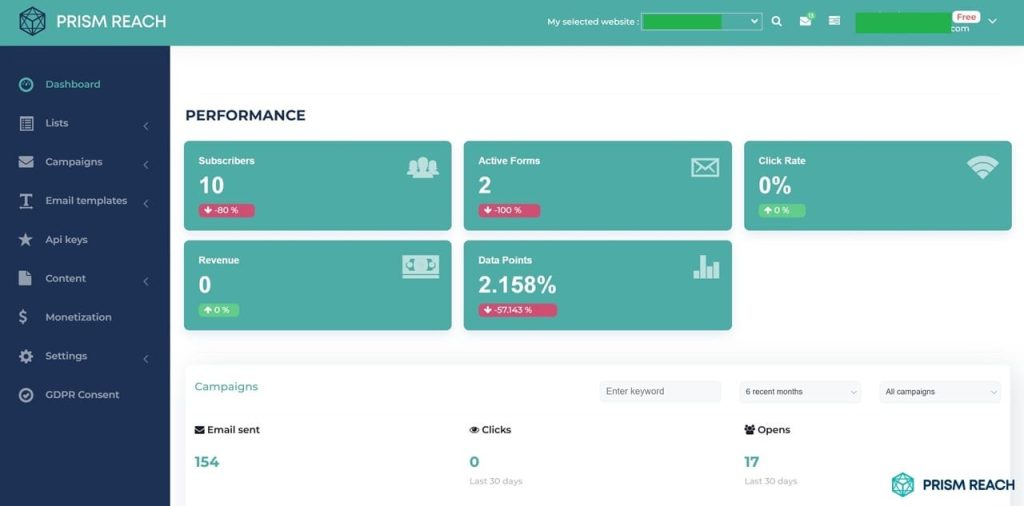
Key Features
AI-Powered Personalization:
- Content Clustering: Utilizes both open and proprietary AI models to categorize content effectively.
- User Avatars: Enriches user data for creating highly personalized profiles.
- Personalized Introductions: Generates custom introduction paragraphs for each subscriber using advanced data analytics.
- Optimal Sending Times: Uses predictive analytics to determine the best times to send newsletters, maximizing subscriber engagement.
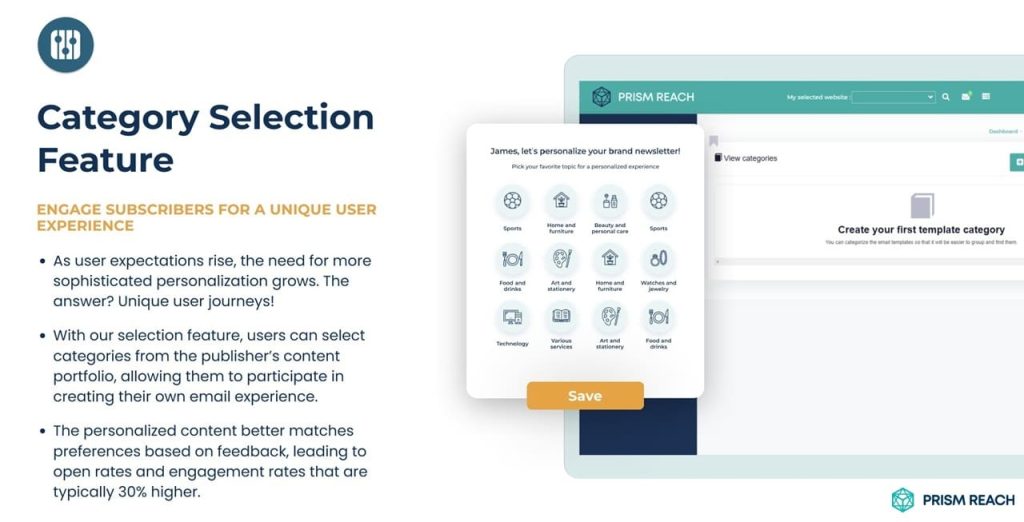
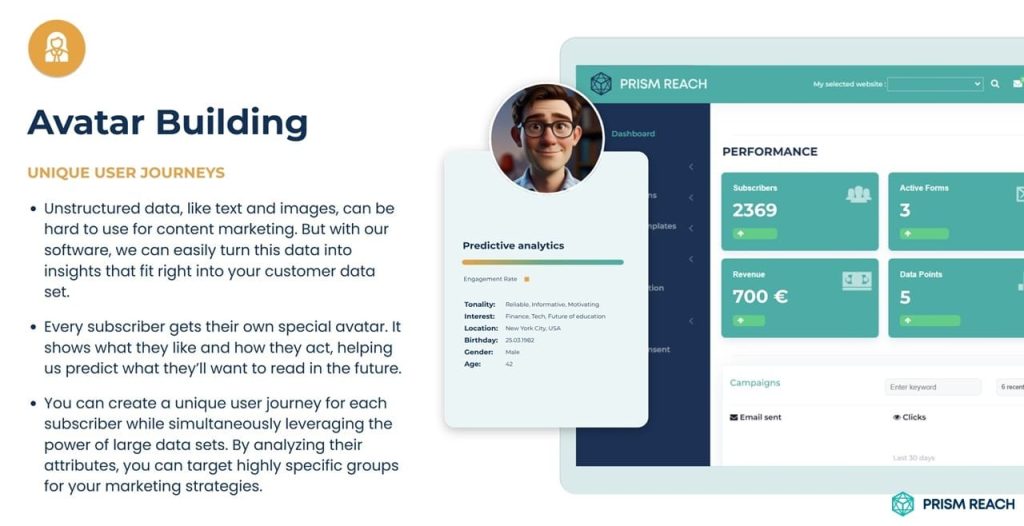
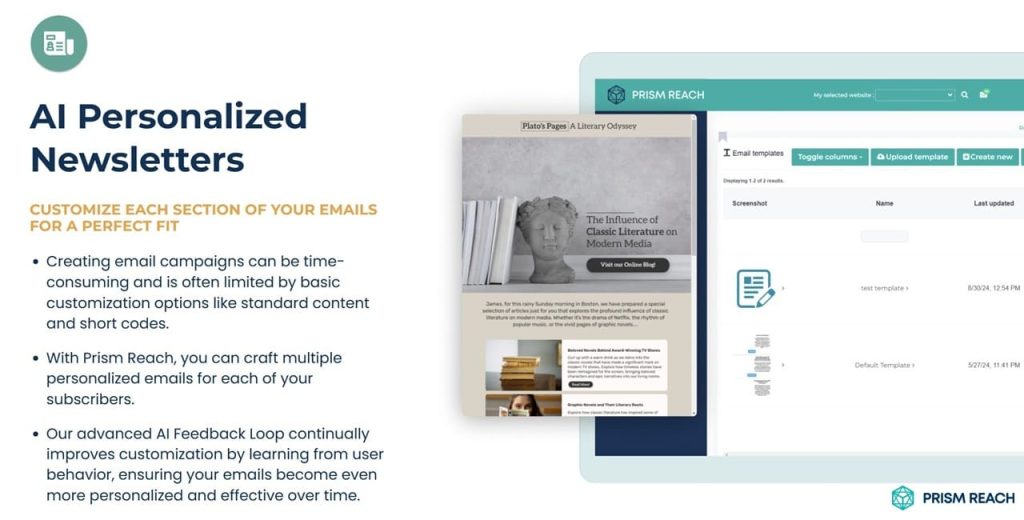
Seamless Setup and Integration:
- Quick Setup: The platform can be integrated within 10 minutes, making it user-friendly.
- One-Click Uploads: Facilitates easy migration of existing subscriber lists.
- AI-Enhanced Sign-Up Forms: These forms are designed to increase sign-up rates through AI-generated content tailored to the user’s context and improve GDPR compliance.
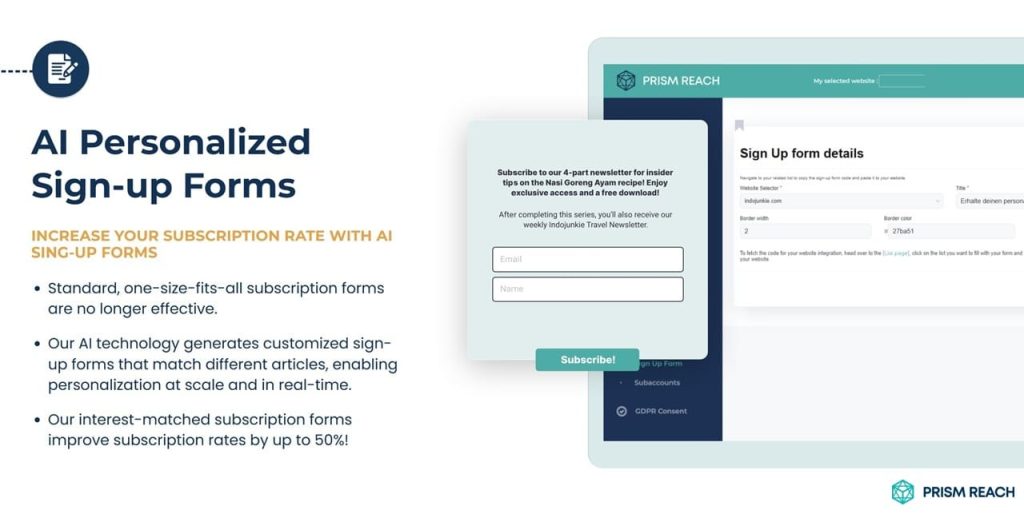
Dynamic Content Selection: The AI determines the most relevant content for each subscriber, enhancing the personalization of each newsletter.
Advertising Network and Swap Network:
- Targeted Advertising: Provides a platform for targeted advertising similar to major online ad networks, allowing for precise ad placement based on subscriber data.
- Mutual Promotion: Facilitates mutual promotion among publishers, broadening content reach and enhancing subscriber engagement.
Advanced AI Features:
- Anti-Spam Checks: Ensures high deliverability by avoiding spam filters.
- High Deliverability: Focuses on maintaining engagement levels and avoiding spam filters.
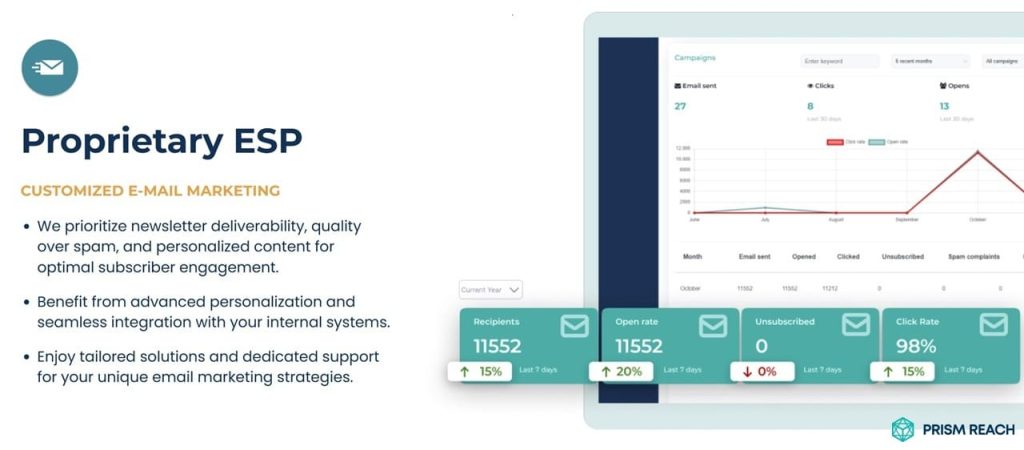
Benefits of Prism Reach
- Improved Productivity: Automation and AI-driven insights significantly reduce the time required to create and manage campaigns.could be particularly beneficial for publishers and content-heavy businesses looking to maximize engagement and revenue from their email lists.
- Increased Engagement: Publishers report up to 40% higher engagement rates due to the personalized nature of the content.
- Higher Revenue: Tailored advertising and efficient content targeting lead to higher monetization rates for published newsletters.
Upgrade Your Email Marketing with AI Personalization!
FAQ
Conclusion
In the Mailchimp vs Campaign Monitor comparison, there’s no universal best choice. Mailchimp emerges as the more comprehensive solution, ideal for businesses seeking advanced features, especially in ecommerce and cross-channel marketing. Its extensive integrations, advanced automation, and robust analytics make it suitable for complex marketing strategies.
Campaign Monitor, with its focus on simplicity and deliverability, is an excellent choice for businesses prioritizing straightforward email campaigns and ease of use. Its streamlined interface and strong emphasis on inbox placement make it particularly attractive for those new to email marketing or those who prefer a no-frills approach.
As the email marketing landscape evolves, innovative solutions like Prism Reach are introducing new possibilities with personalization and AI-driven content delivery. For businesses looking to provide truly individualized experiences to their subscribers, exploring these cutting-edge options may be worthwhile. Prism Reach’s AI-powered personalization, automated campaign creation, and monetization opportunities offer significant advantages that complement and, in some cases, surpass the offerings of traditional platforms.
Ultimately, the choice between Mailchimp, Campaign Monitor, or newer alternatives like Prism Reach depends on your specific business needs, technical expertise, and marketing goals. By carefully considering the strengths and limitations of each platform, you can select the tool that best aligns with your email marketing strategy and helps you achieve your business objectives.
Sources
- Mailchimp. (2023). Features and pricing information. Retrieved from https://mailchimp.com
- Campaign Monitor. (2023). Platform capabilities and pricing details. Retrieved from https://www.campaignmonitor.com
- Martin Bailey Photography. (2014). Mailchimp vs Campaign Monitor Podcast 434. Retrieved from https://martinbaileyphotography.com/2014/08/12/mailchimp-vs-campaign-monitor-podcast-434/
- Mailmodo. (n.d.). Comparison Mailchimp vs Campaign Monitor vs Mailmodo. Retrieved from https://www.mailmodo.com/comparison/mailchimp-vs-campaignmonitor-vs-mailmodo/